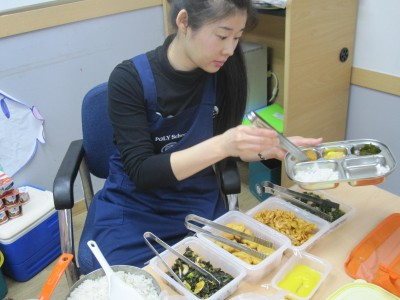Additional lunchtime side dishes at my academy include ddeok (squishy gluttenous rice-flour cakes covered in varying sauces), fish or meat (always a small amount, seemingly only used to flavor the sticky white rice), egg-squid mini pancakes, seaweed or another thin soup (usually fish or seaweed), spicy squid, anchovies, fruit or cherry tomatoes, and perhaps shot-sized yogurt drinks for dessert. I find it incredibly strange that they eat ddeok with rice, since it's essentially the same. Soy-marinated hardboiled quail eggs, dried seaweed, brown roots, and mushroom concoctions are some of my personal favorites. Potatoes and bread aren't often eaten as part of main courses. Potatoes are sometimes eaten roasted or boiled and whole as an on-the-go snack. Bead is most often served with coffee, or sometimes my kids eat small sweet buns for breakfast.
在我的学院里额外的午餐配菜包括炒年糕(粘糊糊的被蘸上各种酱汁的用米粉做的糕点),鱼或肉(总是少量,看起来只用于给粘米饭调味),鸡蛋鱿鱼小煎饼,海带汤或另一种淡汤(通常是鱼或海带),辣鱿鱼、凤尾鱼、水果或圣女果,也许还有搭配甜点的少量的酸奶。他们炒年糕和米饭一起吃,我觉得这非常奇怪,因为两者本质上是一样的。卤水鹌鹑蛋、干海带、 褐根和蘑菇的混合物是我本人相当喜欢的。土豆和面包不经常作为主食的一部分。土豆有时烤着或煮着吃,或者整个作为随身携带的零食。面包通常来说搭配咖啡一起吃,有时我的孩子们也会吃小甜面包当作早餐。

Teacher Jenny dishes up lunch for the preschoolers. This is the same meal Eric is eating in the first picture.
Picnic field trips with preschoolers are fantastic. Instead of PB&Js, they eat kimbap—a popular "fast food" which is almost like sushi roll—except you don't always get sushi. You choose from a variety of fillings (breaded pork, kimchi, vegetables, tuna, ham and egg…) Most Korean mothers prepare this for their kids, or a roll costs between $1-$3 in a local shop. On field trip days, I roam back and forth among miniature lunchboxes, begging handouts. And the side dishes these children pack—they're amazing:imitation crab, roasted shelled walnuts, fresh pineapple, and peaches and watermelon are all accompanied by adorable trainer chopsticks, a bottle of juice, and perhaps some cookies or a small bag of puffed snackage.
珍妮老师正在为学前班儿童配置午餐。这些菜肴与Eric在第一幅图中的菜肴是一样的。
与学龄前儿童一起野餐实在是太棒了,他们吃韩式紫菜包饭而不是花生酱三明治。韩式紫菜包饭是一种流行的“快餐”,几乎像是寿司卷 - 只是不全是寿司,你可以选择许多种食材(炸猪肉,泡菜,蔬菜,金枪鱼,火腿和鸡蛋...)填充进去。大多数韩国母亲为他们的孩子准备的就是这种包饭,或者去当地的商店购买,大约1到3美元一个。在郊游的时候,我在这些小餐盒之间来回漫步,与他们分享美食。这些孩子们带的配菜也是十分令人惊羡的:用漂亮的筷子插好的仿制蟹肉,烤带壳核桃,新鲜菠萝,桃子和西瓜,一瓶果汁,也许还有一些饼干或一小袋膨化食品。














